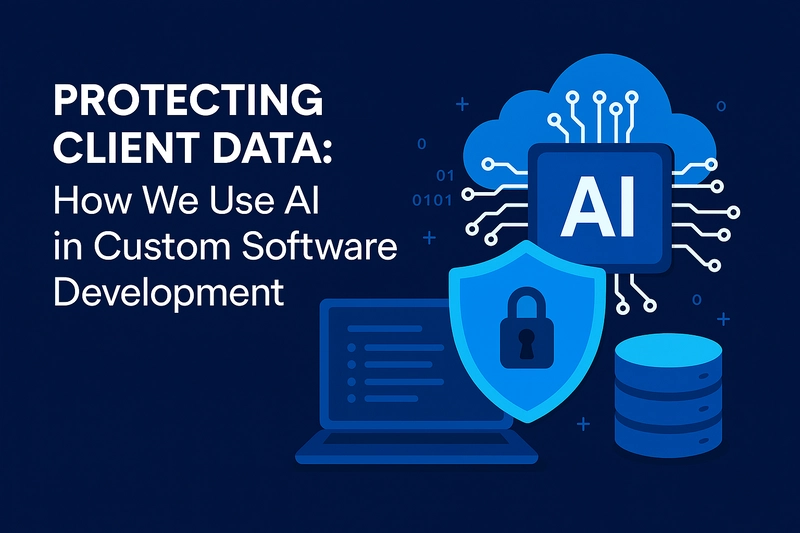Build Faster and Smarter The Best APIs for Full-Stack Developers
As a full-stack developer, using the right APIs can make development faster, easier, and more efficient. From testing and debugging to authentication, payments, AI, and monitoring, these tools help streamline workflows and reduce manual effort. Whether you are building a real-time app, managing serverless functions, or optimizing performance, using the best APIs ensures smoother integration and better scalability. API Development & Testing Tools 1. Postman Explanation: Postman provides a unified platform for designing, testing, and documenting APIs through collaborative workspaces and automated workflows. Why Use: Its visual interface eliminates manual cURL commands, enabling teams to validate API behavior before frontend integration. How It Is Useful for Us: Postman streamlines API development by allowing teams to collaborate on API design and testing, reducing errors and improving overall efficiency. Check Postman 2. Swagger (OpenAPI) Explanation: A specification-first framework that auto-generates interactive API documentation and client SDKs from YAML/JSON definitions. Why Use: Ensures design consistency across distributed teams by serving as a single source of truth for endpoints and data models. How It Is Useful for Us: Swagger helps maintain API consistency and clarity, making it easier for developers to understand and integrate APIs across different projects. Check Swagger 3. Apidog Explanation: Combines API design, testing, and mock server creation with code generation for frameworks like Express.js and Flask. Why Use: Reduces context-switching by providing design-time error checking against OpenAPI specs while generating ready-to-use boilerplate. How It Is Useful for Us: Apidog accelerates prototyping by automating API scaffolding, allowing developers to focus on core logic rather than boilerplate code. Check Apidog 4. Insomnia Explanation: Lightweight API client supporting REST, GraphQL, and gRPC with environment variable management and automated test suites. Why Use: Simplifies debugging stateful APIs (e.g., OAuth2 flows) through cookie persistence across requests and dynamic token renewal. How It Is Useful for Us: Insomnia’s features help developers efficiently debug complex API workflows, reducing the time spent on troubleshooting authentication issues. Check Insomnia 5. Kong Gateway Explanation: Cloud-native API gateway handling traffic routing, rate limiting, and authentication for microservices. Why Use: Decouples security policies (JWT validation, IP whitelisting) from application code, enabling centralized governance. How It Is Useful for Us: Kong provides a scalable and secure way to manage API traffic, ensuring that security policies are consistently enforced across all services. Check Kong Gateway Frontend-Backend Integration 6. Firebase Realtime Database Explanation: NoSQL cloud database with automatic synchronization across web/mobile clients and offline persistence. Why Use: Eliminates websocket server maintenance while ensuring collaborative apps (e.g., live editors) reflect changes instantly. How It Is Useful for Us: Firebase Realtime Database allows developers to build real-time applications without worrying about backend infrastructure, enhancing user experience with instant data updates. Check Firebase 7. Stripe Payments API Explanation: PCI-compliant payment processing with pre-built UI components and subscription management webhooks. Why Use: Reduces PCI DSS compliance overhead by 90% compared to in-house payment gateways through tokenized transactions. How It Is Useful for Us: Stripe simplifies payment processing by handling security and compliance, allowing developers to focus on core application logic. Check Stripe 8. Auth0 Authentication Explanation: Identity-as-a-service supporting 30+ social logins, passwordless auth, and enterprise SAML integrations. Why Use: Offloads credential storage risks—Auth0 handles encryption, brute-force protection, and breach monitoring. How It Is Useful for Us: Auth0 provides robust authentication solutions, freeing developers from managing complex identity systems and enhancing application security. Check Auth0 Infrastructure & Deployment 9. AWS Lambda Explanation: Serverless compute service executing code in response to HTTP requests via API Gateway or event triggers. Why Use: Eliminates server provisioning—scale from 0 to 10,000 requests/sec without capacity planning. How It Is Useful for Us: AWS Lambda enables cost-effective scalability by only charging for actual execution time, reducing operational overhead. Check AWS Lambda 10. Docker Engine API Explanation: Programmatic control over container lifecycle (build, run, ship) via REST endpoints. Why Use: Enables CI/CD pipelines to automate image builds and deployments across hybrid clouds. How It Is

As a full-stack developer, using the right APIs can make development faster, easier, and more efficient. From testing and debugging to authentication, payments, AI, and monitoring, these tools help streamline workflows and reduce manual effort. Whether you are building a real-time app, managing serverless functions, or optimizing performance, using the best APIs ensures smoother integration and better scalability.
API Development & Testing Tools
1. Postman
Explanation: Postman provides a unified platform for designing, testing, and documenting APIs through collaborative workspaces and automated workflows.
Why Use: Its visual interface eliminates manual cURL commands, enabling teams to validate API behavior before frontend integration.
How It Is Useful for Us: Postman streamlines API development by allowing teams to collaborate on API design and testing, reducing errors and improving overall efficiency.
2. Swagger (OpenAPI)
Explanation: A specification-first framework that auto-generates interactive API documentation and client SDKs from YAML/JSON definitions.
Why Use: Ensures design consistency across distributed teams by serving as a single source of truth for endpoints and data models.
How It Is Useful for Us: Swagger helps maintain API consistency and clarity, making it easier for developers to understand and integrate APIs across different projects.
3. Apidog
Explanation: Combines API design, testing, and mock server creation with code generation for frameworks like Express.js and Flask.
Why Use: Reduces context-switching by providing design-time error checking against OpenAPI specs while generating ready-to-use boilerplate.
How It Is Useful for Us: Apidog accelerates prototyping by automating API scaffolding, allowing developers to focus on core logic rather than boilerplate code.
4. Insomnia
Explanation: Lightweight API client supporting REST, GraphQL, and gRPC with environment variable management and automated test suites.
Why Use: Simplifies debugging stateful APIs (e.g., OAuth2 flows) through cookie persistence across requests and dynamic token renewal.
How It Is Useful for Us: Insomnia’s features help developers efficiently debug complex API workflows, reducing the time spent on troubleshooting authentication issues.
5. Kong Gateway
Explanation: Cloud-native API gateway handling traffic routing, rate limiting, and authentication for microservices.
Why Use: Decouples security policies (JWT validation, IP whitelisting) from application code, enabling centralized governance.
How It Is Useful for Us: Kong provides a scalable and secure way to manage API traffic, ensuring that security policies are consistently enforced across all services.
Frontend-Backend Integration
6. Firebase Realtime Database
Explanation: NoSQL cloud database with automatic synchronization across web/mobile clients and offline persistence.
Why Use: Eliminates websocket server maintenance while ensuring collaborative apps (e.g., live editors) reflect changes instantly.
How It Is Useful for Us: Firebase Realtime Database allows developers to build real-time applications without worrying about backend infrastructure, enhancing user experience with instant data updates.
7. Stripe Payments API
Explanation: PCI-compliant payment processing with pre-built UI components and subscription management webhooks.
Why Use: Reduces PCI DSS compliance overhead by 90% compared to in-house payment gateways through tokenized transactions.
How It Is Useful for Us: Stripe simplifies payment processing by handling security and compliance, allowing developers to focus on core application logic.
8. Auth0 Authentication
Explanation: Identity-as-a-service supporting 30+ social logins, passwordless auth, and enterprise SAML integrations.
Why Use: Offloads credential storage risks—Auth0 handles encryption, brute-force protection, and breach monitoring.
How It Is Useful for Us: Auth0 provides robust authentication solutions, freeing developers from managing complex identity systems and enhancing application security.
Infrastructure & Deployment
9. AWS Lambda
Explanation: Serverless compute service executing code in response to HTTP requests via API Gateway or event triggers.
Why Use: Eliminates server provisioning—scale from 0 to 10,000 requests/sec without capacity planning.
How It Is Useful for Us: AWS Lambda enables cost-effective scalability by only charging for actual execution time, reducing operational overhead.
10. Docker Engine API
Explanation: Programmatic control over container lifecycle (build, run, ship) via REST endpoints.
Why Use: Enables CI/CD pipelines to automate image builds and deployments across hybrid clouds.
How It Is Useful for Us: Docker’s API ensures consistent environments across development, staging, and production, reducing deployment errors.
11. Genezio Serverless Platform
Explanation: Framework-agnostic serverless platform optimizing cold start times to <100ms.
Why Use: Migrate legacy monoliths incrementally—deploy individual functions without rewriting entire apps.
How It Is Useful for Us: Genezio accelerates serverless adoption by minimizing cold start latency, improving application responsiveness.
Data Management
12. GraphQL (Apollo)
Explanation: Query language enabling clients to request exact data needs via a single endpoint.
Why Use: Prevents over-fetching—reduce payload sizes by 60% compared to REST endpoints returning fixed structures.
How It Is Useful for Us: GraphQL enhances frontend performance by allowing precise data fetching, reducing network latency and improving user experience.
13. MongoDB Atlas Data API
Explanation: HTTP interface exposing CRUD operations on MongoDB collections without backend code.
Why Use: Frontend teams prototype faster by querying Atlas directly from React/Vue with RBAC policies.
How It Is Useful for Us: MongoDB Atlas Data API accelerates development by enabling frontend teams to interact directly with the database, streamlining prototyping and reducing backend bottlenecks.
Monitoring & Analytics
14. Sentry Error Tracking
Explanation: Full-stack monitoring capturing JavaScript exceptions, Python tracebacks, and mobile app crashes.
Why Use: Correlate frontend errors (React hydration fails) with backend API timeouts via distributed tracing.
How It Is Useful for Us: Sentry provides comprehensive error tracking, helping developers quickly identify and resolve issues across the entire application stack.
15. Google Analytics Measurement Protocol
Explanation: Low-level API for sending custom events from servers, IoT devices, or offline systems to GA4.
Why Use: Track cross-platform journeys (web → mobile → POS) with unified user IDs.
How It Is Useful for Us: Google Analytics Measurement Protocol allows for unified tracking across different platforms, providing a complete view of user interactions.
Communication APIs
16. Twilio Programmable Messaging
Explanation: Global SMS/MMS API with carrier-grade deliverability and two-way conversation management.
Why Use: Localize messages via 1,800+ carrier partnerships—ensure 99.95% delivery rates in emerging markets.
How It Is Useful for Us: Twilio’s messaging service ensures reliable and fast message delivery worldwide, enhancing communication with users.
17. SendGrid Email API
Explanation: Transactional email service with dynamic templating, A/B testing, and spam score previews.
Why Use: Maintain inbox placement via dedicated IP warmup and reputation monitoring.
How It Is Useful for Us: SendGrid helps improve email deliverability and engagement through customizable templates and analytics, ensuring messages reach users effectively.
AI/ML Integration
18. OpenAI API
Explanation: Cloud-hosted LLMs (GPT-4, DALL-E) accessible via REST endpoints for text/image generation.
Why Use: Add AI features without GPU infrastructure—process 10M tokens/month at $0.002/1K tokens.
How It Is Useful for Us: OpenAI’s API enables developers to integrate AI capabilities into applications without requiring extensive ML expertise or infrastructure.
19. Tensorflow Serving
Explanation: High-performance serving system for ML models with REST/gRPC endpoints and versioned rollouts.
Why Use: Deploy PyTorch/TensorFlow models as microservices—handle 5K RPS per GPU instance.
How It Is Useful for Us: TensorFlow Serving allows for efficient deployment and management of machine learning models, ensuring they are scalable and reliable.
Emerging Standards
20. WebAssembly
Explanation: Binary instruction format enabling near-native code execution in browsers via C/Rust compiles.
Why Use: Offload CPU-intensive tasks (video transcoding) from backend to client devices.
How It Is Useful for Us: WebAssembly enables developers to leverage client-side processing for complex tasks, reducing server load and improving application performance.










































































































































































![[The AI Show Episode 143]: ChatGPT Revenue Surge, New AGI Timelines, Amazon’s AI Agent, Claude for Education, Model Context Protocol & LLMs Pass the Turing Test](https://www.marketingaiinstitute.com/hubfs/ep%20143%20cover.png)


































































































































![From drop-out to software architect with Jason Lengstorf [Podcast #167]](https://cdn.hashnode.com/res/hashnode/image/upload/v1743796461357/f3d19cd7-e6f5-4d7c-8bfc-eb974bc8da68.png?#)













































































































.png?width=1920&height=1920&fit=bounds&quality=70&format=jpg&auto=webp#)


.png?width=1920&height=1920&fit=bounds&quality=70&format=jpg&auto=webp#)




































































































































![Apple Rushes Five Planes of iPhones to US Ahead of New Tariffs [Report]](https://www.iclarified.com/images/news/96967/96967/96967-640.jpg)
![Apple Vision Pro 2 Allegedly in Production Ahead of 2025 Launch [Rumor]](https://www.iclarified.com/images/news/96965/96965/96965-640.jpg)


































































































































